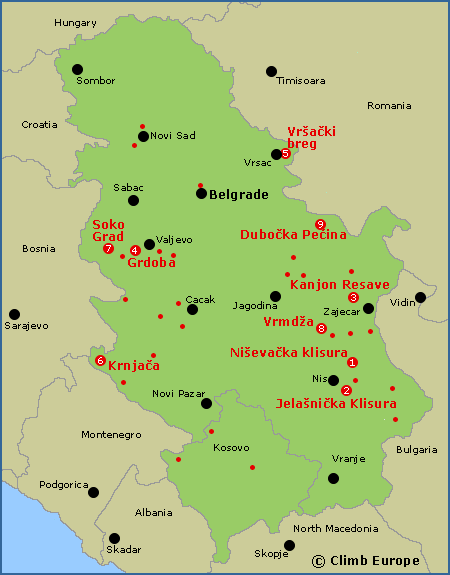Sport climbing and rock climbing in Serbia
Serbia is a country with a diverse mountainous karst landscape of deep gorges, remote valleys, and huge caves. Scattered across Serbia are many excellent limestone crags offering solitude and adventure when compared to other European countries.
There are around 40 different crags across Serbia offering mainly single pitch sport routes, along with some multi-pitch routes and bouldering. These crags provide around 2,200 routes across a wide range of grades from low F5’s to high F8’s, with many projects still open. However, like most of the Balkans there is the potential for much more development in the future. Niš, the 3rd largest city in Serbia, can claim to be the centre of climbing in Serbia with it’s 2 largest climbing areas close by (Niševačka klisura and Jelašnička Klisura). Some of the best crags in Serbia are as follows:
1 - Niševačka klisura is Serbia’s largest sport crag with approximately 300 routes. With short approaches, and routes across a wide range of grades, it has quickly become the most popular climbing area in the country. The brown, grey and white limestone offers all styles of climbing, half the walls are vertical and slabs, and the other half overhanging walls including roofs. The different sectors face all directions making it possible to climb here all year round.
2 - Jelašnička Klisura is a beautiful canyon with a maze of sharp dolomitic limestone spires, slabs, and overhangs. It is Serbia’s 2nd largest crag with over 200 sport routes across a wide range of grades. There is also some bouldering and a few multi-pitch routes stacked across the multiple levels of the canyon.
3 - Kanjon Resave is a remote canyon at the foot of Mount Beljanica (1,339m), filled with dramatic limestone cliffs, dense forests, and the clear blue water of the Resave River. There are 160+ routes, mainly from low F5’s to F7’s, offering a variety of styles. Everything from slabs, vertical faces, overhangs, with cracks, crimps and tufas.
Map of the main sport climbing areas in Serbia

4 - Grdoba & Džaveri. Grdoba is one of Serbia’s most popular crags, due to its proximity to Belgrade and the possibility to climb year-round. Although there are some easier routes, the crag is more suited for those who enjoy long routes in the F7’s and F8’s grade range. Džaveri is close by and is a great venue with easier routes in a beautiful forest.
5 - Vršački breg is Serbia’s largest bouldering venue, set in a magical forest. The rocks are gneiss and schist that is super-sharp requiring some tough skin. Of the 200+ problems, there are short two-move problems to 7m highballs of varying difficulty.
6 – Krnjača is positioned in a stunning wild corner of Serbia, close to the borders of Montenegro and Bosnia, and this remote location keeps visitor numbers low. The climbing is on good, rough limestone offering all kinds of climbing styles, with around 125 routes. The routes range from beginner friendly slabs and vertical walls to challenging overhangs and technical routes with plenty of pockets and crimps, catering for climbers across a wide range of grades.
7 - Soko Grad is a great climbing area situated on a hill in the vicinity of the remains of a famous ancient fortress. With just over 100 routes there’s a great mix of beautiful routes in the intermediate to harder grade range (F6 to F7c). The routes are situated in all orientations making it possible to climb here from March through to October.
8 – Vrmdža is a small village close to the remains of a Latin grad Fortress. The climbing is spread out along a beautiful river, as well as the hills around the fortress ruins. Climbers can expect predominantly technical climbing, a paradise for those who enjoy intricate footwork and precise movement, especially at grades from F6a to F7c. The high quality, frictional limestone rock features slabs and vertical faces, but no overhangs. There are 120 routes here that face all kinds of orientations, making climbing possible except during the hottest or coldest months.
9 - Dubočka Pećina is one of the longest caves in Serbia at 2.7km long. The climbing is located in the cave entrance, providing cooler temperatures. This protection from the sun and light rain make it an ideal location during the summer. The climbing style is mostly vertical, with well bolted, technical routes. Of the 22 routes currently established, the majority of these are in the F6’s, with a few easier routes in the F5’s and a few challenging F7’s.
Serbia Climbing Logistics and Beta
Serbia rock climbing guidebook. The comprehensive guidebook for Serbia is called Serbia Rock Climbing Guidebook. It 38 separate crags across Serbia, describing 2,200 routes, including single pitch sport routes, multi-pitch routes and bouldering. At the start of the guidebook there is plenty of information regarding travel, transport, accommodation, food and drink, plus money matters, as well as health and safety tips.
Serbian Climbing season. The best time of year to climb in Serbia is in the spring and autumn when you will find the best conditions. Serbia has a mostly continental climate, with hot summers and cold winters. However, many of the major crags face multiple directions allowing climbers to chase the sun or shade, making it possible to climb during most of the year.